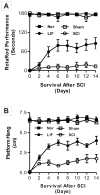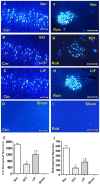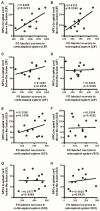The neuron regrowth is associated with the proliferation of neural precursor cells after leukemia inhibitory factor administration following spinal cord injury in mice
- PMID: 25542011
- PMCID: PMC4277544
- DOI: 10.1371/journal.pone.0116031
The neuron regrowth is associated with the proliferation of neural precursor cells after leukemia inhibitory factor administration following spinal cord injury in mice
Abstract
Objectives: To explore whether LIF could promote the proliferation of neural precursor cells (NPCs) and to analyze the correlation between increased NPCs and FluoroGold (FG) labeled neurons in mice after spinal cord injury (SCI).
Methods: Motor behavior was assessed using Rotarod and Platform Hang tests; neurons in the corticospinal and rubrospinal systems were labeled with FG, NPCs were immustained with nestin-FITC conjugate. The numbers of FG-labeled neurons and NPCs were estimated, and the correlation between FG-labeled neurons and NPCs was assessed.
Results: Mice in the SCI group showed negligible recovery of locomotor behavior; in contrast, mice in the LIF group showed a statically significant improvement. Both FG-labeled neurons and NPCs were significantly increased in the LIF group compared to the SCI group, and this increase in FG-labeled neurons and NPCs showed a clear association above the lesion level.
Conclusions: LIF could promote locomotive behaviors in mice post-SCI by encouraging the proliferation of NPCs; LIF may in fact be a potential cytokine for the induction of NPCs post-SCI.
Conflict of interest statement
Figures




References
-
- Bazley FA, Pourmorteza A, Gupta S, Pashai N, Kerr C, et al. (2012) DTI for assessing axonal integrity after contusive spinal cord injury and transplantation of oligodendrocyte progenitor cells. Conf Proc IEEE Eng Med Biol Soc 2012:82–85. - PubMed
-
- Kumamaru H, Saiwai H, Kubota K, Kobayakawa K, Yokota K, et al. (2013) Therapeutic activities of engrafted neural stem/precursor cells are not dormant in the chronically injured spinal cord. Stem Cells 31:1535–1547. - PubMed
Publication types
MeSH terms
Substances
LinkOut - more resources
Full Text Sources
Other Literature Sources
Medical

